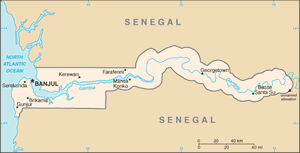The Geography of Gambia, The
The Geography of Gambia, The
Gambian Geography
Location: Western Africa, bordering the North Atlantic Ocean and Senegal
Geographic coordinates: 13 28 N, 16 34 W
Map references: Africa
Area: total: 11,300 sq km land: 10,000 sq km water: 1,300 sq km
Area - comparative: slightly less than twice the size of Delaware
Land boundaries: total: 740 km border countries: Senegal 740 km
Coastline: 80 km
Maritime claims: territorial sea: 12 nm contiguous zone: 18 nm exclusive fishing zone: 200 nm continental shelf: extent not specified
Climate: tropical; hot, rainy season (June to November); cooler, dry season (November to May)
Terrain: flood plain of the Gambia River flanked by some low hills
Elevation extremes: lowest point: Atlantic Ocean 0 m highest point: unnamed location 53 m
Natural resources: fish, titanium (rutile and ilmenite), tin, zircon, silica sand, clay, petroleum
Land use: arable land: 27.88% permanent crops: 0.44% other: 71.68% (2005)
Irrigated land: 20 sq km (2003)
Natural hazards: drought (rainfall has dropped by 30% in the last 30 years)
Environment - current issues: deforestation; desertification; water-borne diseases prevalent
Environment - international agreements: party to: Biodiversity, Climate Change, Climate Change-Kyoto Protocol, Desertification, Endangered Species, Hazardous Wastes, Law of the Sea, Ozone Layer Protection, Ship Pollution, Wetlands, Whaling signed, but not ratified: none of the selected agreements
Geography - note: almost an enclave of Senegal; smallest country on the continent of Africa


